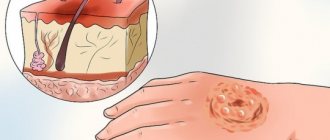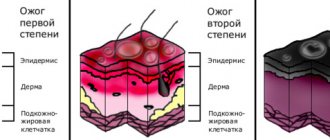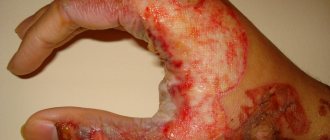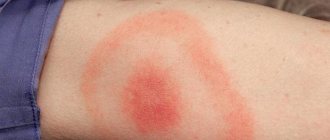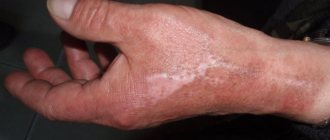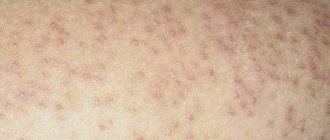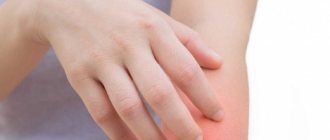Causes
In addition to the direct effects of cold, frostbite can occur due to:
- climatic factors (strong wind, high humidity, temperature changes);
- smoking;
- tight shoes or constrictive clothing;
- alcohol intoxication;
- overwork;
- vascular diseases;
- exhaustion;
- previous frostbite.
The resulting vascular spasm and slowing of blood flow cause thrombosis and tissue nutritional disorders. These processes lead to necrosis (necrosis) of the skin and deeper layers.
First aid for burns
First aid for burns consists of eliminating the negative factor: you need to move away the source of electric current, wash off the chemical, cover the body from the sun, etc.
You can reduce the pain from a burn by using cold water or an ice pack, this will help reduce the severity of the damage. Apply a dry, sterile dressing, such as a bandage or clean cotton cloth, to the affected surface.
Treatment of burns
A traumatologist will treat the affected area.
For example, a wound resulting from a chemical burn is treated with a neutralizing substance (if the burn was caused by lime, then glucose is used).
Next, the doctor removes part of the non-viable skin and adhered fragments of clothing from the wound, removes blisters, and applies a dry sterile bandage or ointment mesh bandage to the wound. When treating burns, painkillers, a course of antibiotics, and a tetanus shot are prescribed.
Symptoms
Clinically, the following periods of frostbite development are distinguished:
- pre-reactive or latent (lasts several hours - days);
- reactive (occurs during warming and restoration of blood flow):
- early (lasts up to 12 hours from the start of warming, microcirculation disorders occur, disturbances in the structure of the vascular wall, blood clots form);
- late (necrosis develops and infection may occur).
First, frostbitten patients experience numbness and paresthesia of the affected area; the skin in this area is pale, cold, and its sensitivity is significantly reduced (latent period).
After warming up (reactive period), victims begin to experience itching, pain, tingling, and burning at the site of frostbite. The skin becomes warm, turns red, and swelling occurs.
Local tissue changes vary in depth. Depending on this, it is customary to indicate the degree of frostbite that has developed. But it can only be determined upon the onset of a full-blown reactive period (several days after cold injury). There are four degrees (I-II - superficial, III-IV - deep):
- I degree - the resulting vascular disorders do not affect sensitivity and movements, they disappear after 5 or 7 days;
- II degree - only the superficial skin layer is damaged, in addition to swelling and hyperemia, blisters with transparent contents appear, restoration of the affected skin is observed by the end of the second week;
- III degree – necrosis of the entire skin and underlying tissue is observed, the resulting blisters are filled with hemorrhagic contents, the skin has a bluish-purple color, swelling spreads beyond the affected area, sensitivity is lost, after rejection of the necrotic scab the skin is not restored, granulations are replaced by rough scars;
- IV degree - necrosis of all soft tissues occurs to the level of joints and bones, clinically at first it is difficult to distinguish it from stage III, the prevalence of edema exceeds the area of the necrotic zone, after about a week the victims develop gangrene (wet or dry) with a distinct line of demarcation.
In addition to local symptoms, with a significant area or depth of the traumatic lesion, general intoxication symptoms appear (fever, nausea, apathy, loss of appetite, tachycardia, etc.).
State Autonomous Institution "Shilkinskaya Central District Hospital"
Frostbite occurs not only in winter, but also in spring and autumn, and even in southern latitudes.
Depending on the etiological factor, there are four main types of frostbite, differing in clinical and morphological picture:
- Frostbite from exposure to dry frost;
- Frostbite that occurs at temperatures above zero;
- Contact frostbite occurring at subcritical temperatures;
- Chill syndrome.
In most cases, frostbite affects peripheral parts of the body (face, feet, ears, nose, etc.).
The first place in the frequency of frostbite is occupied by 1 toe, in second place are the fingers. Mostly exposed or peripheral areas of the body suffer from exposure to low negative temperatures during dry frost. The cellular protoplasm is directly damaged, followed by necrosis or tissue degeneration.
With prolonged intermittent exposure to damp cold, which often occurs in spring, heat transfer increases. This leads to the development of so-called “trench foot,” which is a classic example of grade 4 frostbite at temperatures above zero. As a result of vasomotor and neurotrophic disorders, destructive changes can develop, including tissue necrosis, wet gangrene and sepsis.
Contact frostbite occurs when naked areas of the body (usually hands) come into direct contact with sharply cooled metal objects. Such frostbite is more often observed in wartime among tank crews, rocket crews, pilots, etc.
Chill is understood as a type of chronic frostbite of mainly exposed parts of the body (hands, face, ears, etc.), often arising under the influence of systematic, but mild and short-term cooling. People who have suffered frostbite in the past are most susceptible to chills. Clinically, chills are characterized by swelling, cyanosis, itching and paresthesia of the affected skin. In more severe cases, cracks and ulcers on the skin, secondary dermatoses and dermatitis may develop.
Classification of frostbite by degree:
- I degree: characterized by a disorder of local blood circulation and innervation without subsequent necrosis with a short period of decreased tissue temperature. The victim feels itching, burning pain, paresthesia in the affected areas. The skin is swollen, tense, and has a marbled pattern. All these phenomena disappear in the coming days, but the increased sensitivity of the affected areas of the skin to cold persists for a long time.
- II degree: frostbite is accompanied by swelling and necrosis of the skin. On cyanotic and edematous skin, blisters with transparent exudate form, which can appear several days after warming. The victim notes intense pain in the areas of frostbite, intensifying with increasing swelling; the treatment period for such victims is 3 weeks or more.
- III degree: long period of tissue hypothermia. Necrosis of the entire thickness of the skin occurs along with subcutaneous tissue. Flabby blisters with hemorrhagic contents may form on frostbitten skin. Subjective sensations are more intense and lasting. The skin is pale and cold to the touch. Dead tissue undergoes partial melting and rejection, which is accompanied by suppuration. The resulting defect heals by secondary intention within 30–60 days.
- IV degree: characterized by the longest period of tissue hypothermia and a sharp drop in local tissue temperature. All layers of soft tissue and bone die. The intensity of pain is very varied and does not correspond to the depth and extent of frostbite. Spontaneous rejection of necrotic tissue takes a long time and is often complicated by purulent infection.
First aid
First aid for frostbite in the latent period comes down to the speedy restoration of temperature and blood circulation in the affected tissues; to protect this, first of all, measures are taken to warm the victim. Wet clothes in an insulated room are removed and replaced with dry ones. The victim is warmed by all available methods: using heating pads, warm blankets, envelope bags, and given hot food and drink.
Restore blood circulation in frostbitten areas by rubbing them with cotton wool and alcohol or dry hands, combined with a gentle massage of this area. After warming and pinking of the skin, apply an alcohol or aseptic bandage with a thick layer of cotton wool. It is unacceptable to rub frostbitten areas of the body with snow, as this leads to additional cooling, due to the fact that the temperature of frostbitten tissue is much higher than the temperature of snow and, in addition, this is fraught with the danger of causing microtrauma.
If the situation allows, they actively warm the frostbitten limb in water, immersing it in water at a temperature no higher than 24 degrees, bringing it to 36-40 degrees within 20–30 minutes with simultaneous massage from the periphery to the center, combining it with active movements in the affected limb. After warming and restoration of blood circulation, an insulated aseptic bandage is applied to the limb. Do not lubricate the frostbitten surface with tincture of iodine, dyes, fats and ointments. This makes local observation of the skin and treatment of the frostbitten surface difficult.
Freezing occurs as a result of exhaustion of the adaptive mechanisms of thermoregulation, when the body temperature, under the influence of external cooling, progressively drops, and all vital functions are inhibited until they completely disappear.
As with frostbite, there are two periods in the development of the freezing process: latent and reactive.
Latent period: drowsiness, lethargy, slowness of reactions, speech, movements, and general body tremors predominate. Then comes clouding of consciousness and loss of consciousness, convulsions, stiffening of the muscles, progressive slowdown, weakening and disturbance of the rhythm of breathing, cardiac activity, followed by clinical death. The most important symptom is a drop in temperature in the rectum below 35 degrees. The real threat of death occurs when the temperature in the intestine drops below 25 degrees.
Reactive period: occurs after the body as a whole has warmed up. During this period, various pathological processes may develop in internal organs (pneumonia, nephritis, etc.) and disorders of the nervous system (neuritis, paralysis, trophic lesions, mental and nervous diseases, etc.).
The most important feature of freezing is its phase nature, which clinically manifests itself in the form of three symptom complexes based on rectal temperature indicators.
Adynamic phase . Characterized by a decrease in temperature to 35–32 degrees. In the initial period of temperature decrease, all vital functions of the body increase, the frequency and depth of breathing increase, the pulse quickens and blood pressure and blood flow speed increase, metabolism and oxygen consumption by the body increase. Then there is a decrease in body temperature, accompanied by a drop in basic vital signs. The frequency of breathing and heartbeat decreases, consciousness is depressed, reactions slow down, speech constraint, drowsiness, etc. appear.
Stuporous phase . It should be considered a protective inhibition of the cerebral cortex spreading to the underlying parts of the central nervous system. When the temperature drops to 26–27 degrees, basic vital functions are suppressed. The respiratory and pulse rates slow down, the strength of heart contractions weakens, hypoxia and hypoxemia increase, and trembling stops. Severe muscle rigidity, urinary and fecal incontinence develop. Mental activity is completely suppressed.
Convulsive phase . It occurs when the temperature drops below 26 degrees and is characterized by the extinction of all vital functions. Metabolism sharply decreases and the supply of oxygen to tissues is disrupted. Cardiac activity weakens, blood pressure disappears. The rhythm of breathing is disrupted and it stops. Muscle tone and muscle rigidity disappear. In the final phase of development of extreme inhibition, parabiosis and paralysis of the central nervous system, all vital functions fade away, and clinical death occurs.
The main task of emergency treatment for severe freezing (stuporous and convulsive phase) is rapid active warming, aimed at quickly restoring the normal level of human body temperature.
Passive warming (wrapping up in a warm room, etc.) of such victims should be considered a fruitless waste of time. Fear of the negative consequences of rapid active rewarming is unfounded. The only danger is overheating, which can cause serious consequences even with a slight increase in body temperature. Therefore, rational measures of active warming should ensure the fastest return of body temperature to normal levels and at the same time prevent the danger of overheating.
To actively warm a victim in a stuporous or convulsive phase, it is necessary to place him in a warm bath with water at an initial temperature corresponding to body temperature, but below 22–24 degrees. Within 10–12 minutes, the water temperature is brought to 36–40 degrees and maintained at this level. It is advisable to carefully rub the body with soft washcloths in the bath, which helps restore vascular tone and reflex activity of the nervous system. If the victim's breathing increases to at least 12 per minute, he is taken out of the bath and connected to a ventilator, while simultaneously carrying out the entire range of conservative therapy.
Intravenous administration of glucose solutions with insulin, low-molecular blood substitutes, novocaine and other solutions heated to the victim’s body temperature, as well as the administration of heparin and hormones, are effective.
First medical aid to those who are frozen should be provided as fully as possible, including all methods of actively warming the victim. In the absence of such conditions, it is necessary to urgently evacuate them, taking measures to prevent further heat loss from the body during evacuation.
At the stage of qualified medical care, all frozen people are divided into three groups:
- The first group will include lightly injured people in the adynamic phase, who, after warming and treatment, will be left on the recovery team.
- The second group consists of those who are frozen in a state of moderate severity in a stuporous state, who are taken on stretchers to medical stations, where they are given active warming, after which, in accordance with the indications, they are distributed to functional units, where complex therapy is carried out.
- The third group includes seriously injured people who are in the convulsive phase, who are also warmed up, but more often they use artificial respiration, cardiac massage, etc.
After recovery from a serious condition in the reactive phase, the victims are evacuated to the stage of specialized care for follow-up treatment.
Frostbite in children is far from uncommon. Among the most common frostbites in children is iron frostbite. Children love to see if their tongue sticks to the door handle. In this case, you need to pour warm, but not hot water on the tongue stuck to the iron. If there is a wound, you need to see a doctor.
To prevent accidental frostbite in your child, be sure to wear mittens. You should be careful when walking outside in the cold:
- do not push your child on a swing;
- Do not allow climbing on metal equipment;
- do not give a spatula with a metal handle;
- metal parts of the sled need to be wrapped in a blanket.
REMEMBER that babies' bodies are not yet accustomed to regulating heat exchange, so young children are most prone to frostbite. Even at 0°C, infants can get frostbite. Older children can also get very cold without moving, after standing or sitting outside for a long time. Don’t forget that wet clothes are an additional factor in frostbite. Children can sweat from excess clothing or playing snowballs or other outdoor games. The areas most accessible to frost on a child’s body are: cheeks, chin, fingers, nose, ears. If frostbite occurs on the legs, you need to carry the child in your arms, and not force him to run or knock his legs to warm up.
Frostbite in children can be identified by the following signs:
- pale, cold skin with goosebumps or white patches;
- shiver;
- drowsiness or excessive talkativeness;
- difficulty pronouncing words, abruptness of speech;
- the skin loses sensitivity and becomes hard to the touch;
- body temperature is about 35°C.
For mild frostbite, place the child in a warm bath with a temperature of 36–37°C and bring it to 40°C within 40 minutes. Gently massage parts of the body. After the bath, we dry the baby, apply bandages made of gauze, cotton wool and cellophane, and wrap it in woolen cloth. If frostbite occurs on your fingers, you should definitely place strips of bandage between them. Give your child hot milk or tea.
Choose clothes and shoes for children from high-quality materials that will not allow your child to get wet and freeze. No need for thick overalls. The child should not sweat in it. It is better to buy thermal underwear and wear from -15°C. Shoes and gloves must be waterproof.
It would be good for everyone to know in advance how first aid for frostbite is carried out, but let it not be useful to anyone. By the way, dear women, in severe frosts it is better to avoid wearing earrings, rings, even gold and silver ones.
Be healthy!
Prevention of frostbite
Warming creams
- protect skin at temperatures up to – 50°C;
- resistant to temperature fluctuations;
- shelf life up to 30 months;
- support the skin's natural ability to retain moisture;
- accelerate natural skin regeneration
- do not contain water.
Warm clothes
- dress in several layers - layers of air retain heat;
- wear warm insoles and woolen socks - they absorb moisture, leaving your feet dry;
- do not go out into the cold without warm mittens, a hat and a scarf;
Risk factors for frostbite
- tight and wet clothes and shoes
- weakness, fatigue
- problems with blood vessels
- alcohol intoxication
Diagnosis of frostbite toes:
Before entering a warm room from the cold, tap the toe of one foot on the heel of the other. If the tips of your toes don't feel anything, you have frostbite.
For frostbite:
When indoors, remove damp or holey shoes (do not remove dry ones);
Insulate your feet from heat and wrap them up additionally. This is necessary to warm the body with internal heat, otherwise damaged tissues will be destroyed;
Drink 3-4 glasses of warm sweet tea to warm up from the inside;
If internal warming is accompanied by acute pain, take 2-3 tablets of analgin (in the absence of allergic reactions).
Be sure to consult a doctor for medical help!
When working at low temperatures:
At least once an hour, take off your gloves and check your fingers;
Pay attention to your colleagues and ask them to look at your face.
Frostbite of the nose, ears and fingers is often not noticed by the victim due to loss of sensitivity.
If you notice patches of white skin:
- Rub your palms until you feel warm;
- Place a warm palm on the area of whitened skin; on the nose, cheek or ears for 2–3 minutes;
- Repeat this procedure until the skin turns pink;
- Wrap yourself in a scarf, handkerchief, mitten or hat;
- Go into a warm room as quickly as possible and drink a warm, sweet drink.
Attention! Do not rub frostbitten skin, lubricate it with oils or Vaseline.
Don't be careless about suffering from the cold!
Winter now seems to be in no hurry to come into its own. There are no bitter frosts yet, chilling the blood and soul, especially those who love warmth, cold weather. But does this mean that there is no danger that awaits everyone who inadequately assesses the situation and freezes their legs, arms, nose or ears? These are the parts of the body that are first exposed to cold. Already at three degrees below zero, a person can pay for his carelessness. This is facilitated, first of all, by air humidity and wind, as well as poor body protection with clothing and tight shoes. Despite the seemingly “safe” weather in the department, a third of the patients are already suffering from severe frostbite, which requires surgical intervention. And how many patients receive outpatient treatment!
Among those who sought medical help, many were injured again. The fact is that areas of the body once exposed to frostbite become very sensitive to cold. And mostly these are young people who prefer force to health - short skirts, tight jackets, trousers, gloves, thin tights and tight dress shoes.
People who do not work, drink, or lead a wild lifestyle are also at risk. An important role in determining risk factors is also played by the physiological state of a person: old age, exhaustion, anemia, vitamin deficiencies, depressed state of the nervous system.
Against the background of frostbite, disability occurs. — Fingers and toes are amputated, ears are disfigured. But the most serious consequence is disease of blood vessels and nerve endings, chronic diseases leading to infertility.
The first signs of frostbite are sharp stabbing pain, discoloration of the skin and the inability to use a limb. General freezing is expressed in profound changes in all tissues of the body due to the gradual cessation of blood circulation and the ensuing anemia of the brain.
The very first first aid is to isolate the victim from the ongoing effects of low temperature, actively warming frostbitten limbs and body parts.
First of all, the victim must be wrapped up, a heat-insulating bandage applied to the affected area of the skin and sweet hot tea given - this will improve blood circulation.
You cannot do a massage, although a gentle one - light rubbing (preferably with a woolen cloth) is possible, but not with snow.
Taking a hot bath at home is dangerous, since sudden heating kills small vessels on the phalanges, which leads to tissue necrosis. There were many such cases in the practice of doctors.
Pain management is already under the control of doctors.
You cannot delay hospitalization. If treatment is started on the first day, the results are good.
It is very important to follow simple prevention rules to prevent frostbite. Dressing for the weather is a good idea. Not drinking alcohol before going out is two things. And three - know the first symptoms of frostbite, periodically warm up, and move actively.
The more complete a person’s body and its neurovascular system are, the better the nutrition and composition of the blood, the better protected it is by warm clothing and appropriate shoes, the more hardened it is, the more likely it is not to suffer from the cold.
Treatment of frostbite
They try to move the victim to a warm room as quickly as possible. Next, emergency measures are taken to improve the blood supply to the frostbite site. Sometimes they prevent primary necrosis. For this purpose, use:
- warming general or local (hand, etc.) baths;
- heat-insulating bandages;
- massage;
- hot drink;
- antispasmodics (no-spa, etc.).
Rubbing with snow is strictly prohibited, as it aggravates the cooling and injures already damaged skin.
Further conservative treatment options may include:
- detoxification (hemodesis, etc.);
- heparin;
- cardiac drugs;
- antispasmodics;
- novocaine perineural and case blockades (above the site of injury);
- antibiotics;
- immunomodulators;
- blood substitutes;
- locally – antiseptic dressings, dressings with proteolytic enzymes, ointments;
- oxygen barotherapy;
- physiotherapy (UHF, diathermy, electrophoresis, Sollux lamp, paraffin applications, etc.).
Surgical treatment is necessary in the presence of necrotic foci. Typically, surgical treatment is required 1-2 weeks after frostbite, when a clear demarcation of necrosis is formed (demarcation). Excision of necrosis (necrectomy) is performed, followed by skin grafting or amputation above the demarcation line.
